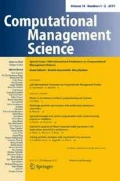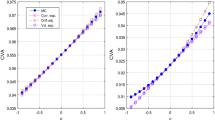Abstract
Credit Value Adjustment is the charge applied by financial institutions to the counter-party to cover the risk of losses on a counterpart default event. In this paper we estimate such a premium under the Bates stochastic model (Bates in The Review of Financial Studies 9(1): 69–107, 1996), which considers an underlying affected by both stochastic volatility and random jumps. We propose an efficient method which improves the Finite-Difference Monte Carlo (FDMC) approach introduced by de Graaf et al. (Journal of Computational Finance 21, 2017) In particular, the method we propose consists in replacing the Monte Carlo step of the FDMC approach with a finite difference step and the whole method relies on the efficient solution of two coupled partial integro-differential equations which is done by employing the Hybrid Tree-Finite Difference method developed by Briani et al. (arXiv:1603.07225 2016;IMA Journal of Management Mathematics 28(4): 467–500, 2017;The Journal of Computational Finance 21(3): 1–45, 2017). Moreover, the direct application of the hybrid techniques in the original FDMC approach is also considered for comparison purposes. Several numerical tests prove the effectiveness and the reliability of the proposed approach when both European and American options are considered. Subject classification numbers as needed.
Similar content being viewed by others
Notes
We performed the numerical tests using a personal computer with the following features. CPU: Intel(R) Core(TM) i5-7200 2.50 GHz; RAM: 8GB, DDR4
References
Albrecher H, Mayer P, Schoutens WT (2007) The little Heston trap. Wilmott Mag 1:83–92
Appolloni E, Caramellino L, Zanette A (2014) A robust tree method for pricing American options with the Cox–Ingersoll—Ross interest rate model. IMA J Manag Math 26(4):377–401
Bates DS (1996) Jumps and stochastic volatility: exchange rate processes implicit in Deutsche mark options. Rev Financ Stud 9(1):69–107
Basel Committee (2004) International convergence of capital measurement and capital standards: a revised framework. Bank for International Settlements Press & Communications CH-4002 Basel, Switzerland
Basel Committee (2010) Basel III: A global regulatory framework for more resilient banks and banking systems. Bank for International Settlements Communications, Basel, Switzerland. https://www.bis.org/publ/bcbs189_dec2010.pdf. ISBN print: 92-9131-859-0 ISBN web: 92-9197-859-0
Borovykh A, Pascucci A, Oosterlee CW (2018) Efficient computation of various valuation adjustments under local Lévy models. SIAM J Financ Math 9(1):251–273
Briani M, Caramellino L, Terenzi G, Zanette A (2016) On a hybrid method using trees and finite-differences for pricing options in complex models. arXiv preprint arXiv:1603.07225
Briani M, Caramellino L, Zanette A (2017) A hybrid approach for the implementation of the Heston model. IMA J Manag Math 28(4):467–500
Briani M, Caramellino L, Zanette A (2017) A hybrid tree/finite-difference approach for Heston–Hull–White type models. J Comput Finance 21(3):1–45
Carr P, Madan D (1999) Option valuation using the fast Fourier transform. J Comput Finance 2(4):61–73
Cox JC, Ingersoll JE Jr (2005) Ross SA (2005) A theory of the term structure of interest rates. Theory Valuat 53:129–164. https://doi.org/10.1142/9789812701022_0005
Feng Y (2017) CVA under Bates model with stochastic default intensity. J Math Finance 7(03):682
Gaillardetz P, Lakhmiri JY (2011) A new premium principle for equity-indexed annuities. J Risk Insur 78(1):245–265
Glau K (2016) A feynman–kac-type formula for Lévy processes with discontinuous killing rates. Finance Stoch 20(4):1021–1059
Goudenège L, Molent A, Zanette A (2016) Pricing and hedging GLWB in the Heston and in the Black–Scholes with stochastic interest rate models. Insur Math Econ 70:38–57
Goudenège L, Molent A, Zanette A (2019) Pricing and hedging GMWB in the Heston and in the Black–Scholes with stochastic interest rate models. Comput Manag Sci 16(1–2):217–248
de Graaf CSL, Kandhai D, Sloot PMA (2017) Efficient estimation of sensitivities for counterparty credit risk with the finite difference Monte Carlo method. J Comput Financ 21(1):83–113
Gregory J (2010) Counterparty credit risk: the new challenge for global financial markets, vol 470. John Wiley & Sons, New Jersey
Haentjens T, In’t Hout KJ (2012) Alternating direction implicit finite difference schemes for the Heston–Hull–White partial differential equation. J Comput Finance 16(1):83
Henry-Labordère P (2012) Cutting CVA’s complexity. Risk 25(7):67
Heston SL (1993) A closed-form solution for options with stochastic volatility with applications to bond and currency options. Rev Financ Stud 6(2):327–343
Hull J (2012) Options, futures, and other derivatives. Prentice Hall, Boston
Jain S, Oosterlee CW (2015) The stochastic grid bundling method: efficient pricing of Bermudan options and their Greeks. Appl Math Comput 269:412–431
Joshi M, Kwon OK (2016) Least squares Monte Carlo credit value adjustment with small and unidirectional bias. Int J Theor Appl Finance 19(08):1650048
Karlsson P, Jain S, Oosterlee CW (2016) Counterparty credit exposures for interest rate derivatives using the stochastic grid bundling method. Appl Math Finance 23(3):175–196
Merton RC (1976) Option pricing when underlying stock returns are discontinuous. J Financ Econ 3(1–2):125–144
Promislow SD (2014) Fundamentals of actuarial mathematics. John Wiley & Sons, New Jersey
Rong S (1997) On solutions of backward stochastic differential equations with jumps and applications. Stoch Process Appl 66(2):209–236
Salmi S, Toivanen J, von Sydow L (2014) An IMEX-scheme for pricing options under stochastic volatility models with jumps. SIAM J Sci Comput 36(5):B817–B834
Voltchkova E, Tankov P (2008) Deterministic methods for option pricing in exponential Lévy models. Premia documentation: http://www.premia.fr
Author information
Authors and Affiliations
Corresponding author
Additional information
Publisher's Note
Springer Nature remains neutral with regard to jurisdictional claims in published maps and institutional affiliations.
A proof of PIDE (8)
A proof of PIDE (8)
This appendix provides a derivation of the PIDE (8) followed by the the CVA price. First of all, we present the proof for the simple case of an underlying evolving according to the Black–Scholes model. Then we consider the Bates model.
1.1 Black–Scholes model
Let S denote the underlying, which is assumed to evolve according to
where \(\eta \) denotes the continuous dividend rate, \(S_{0}\) is a positive value and \(W_{t}\) is a Brownian motion. We assume that counter-party credit risk is diversifiable across a large number of counter-parties. In the case that this assumption is not justified, then the risk-neutral value of the contract can be adjusted using an actuarial premium principle (Gaillardetz and Lakhmiri 2011). Moreover, the fraction of the original counter-parties of the contract who have defaulted before time t is given by
Let us consider a financial product which pays \(\left( 1-R\right) E\left( t\right) \) if the counter-party defaults at time t and 0 otherwise. Then the value of such a product at time 0 - the discounted value of future cash-flows - is equal to the CVA. Therefore, we can consider the CVA as a derivative itself and we denote its financial value at time t with \({\mathcal {C}}\left( t,S_{t},V_{t}\right) \), that is
having \(CVA={\mathcal {C}}\left( 0,S_{0},V_{0}\right) \).
Suppose that the writer of a CVA derivative forms a self-financing portfolio portfolio \(\varPi \) which, in addition to being short to the CVA, is long x units of the index S, i.e.
Then, by Itô’s lemma,
where the last term reflects the cash-flows from the fraction of the original counterparties who default between t and \(t+dt\). Setting \(x=\frac{\partial {\mathcal {C}}}{\partial t}\) in equation (17) gives
Since the portfolio is now (locally) risk-less, it must earn the risk-free interest rate r. Setting \(d\varPi =r\varPi dt\) results in
Therefore, we get
1.2 Bates model
The proof of PIDE (8) in the case of the Bates model may be done by employing the same approach followed in the previous paragraphs for the Black–Scholes model. Alternatively, we can obtain the PIDE (8) by a straightforward application of the Feynman-Kac formula for Lévy processes (Rong 1997; Glau 2016), which can be applied since the CVA is defined as the expected value of a time integral of function depending on a Lévy process.
Rights and permissions
About this article
Cite this article
Goudenège, L., Molent, A. & Zanette, A. Computing credit valuation adjustment solving coupled PIDEs in the Bates model. Comput Manag Sci 17, 163–178 (2020). https://doi.org/10.1007/s10287-020-00365-6
Received:
Accepted:
Published:
Issue Date:
DOI: https://doi.org/10.1007/s10287-020-00365-6




